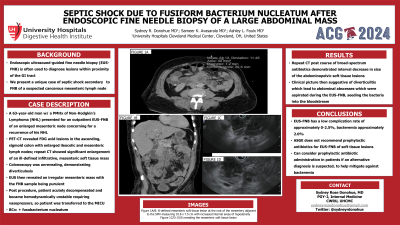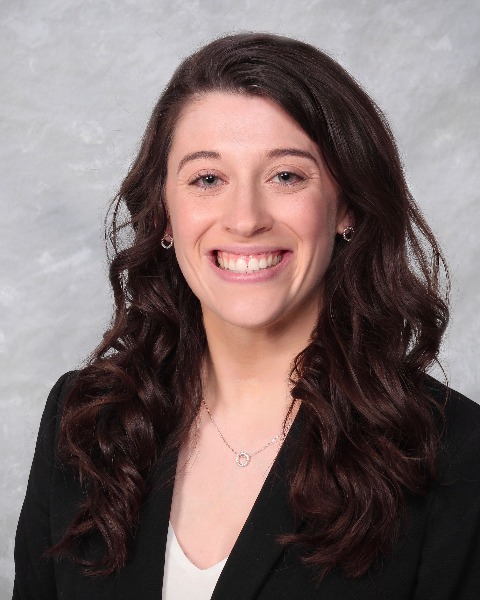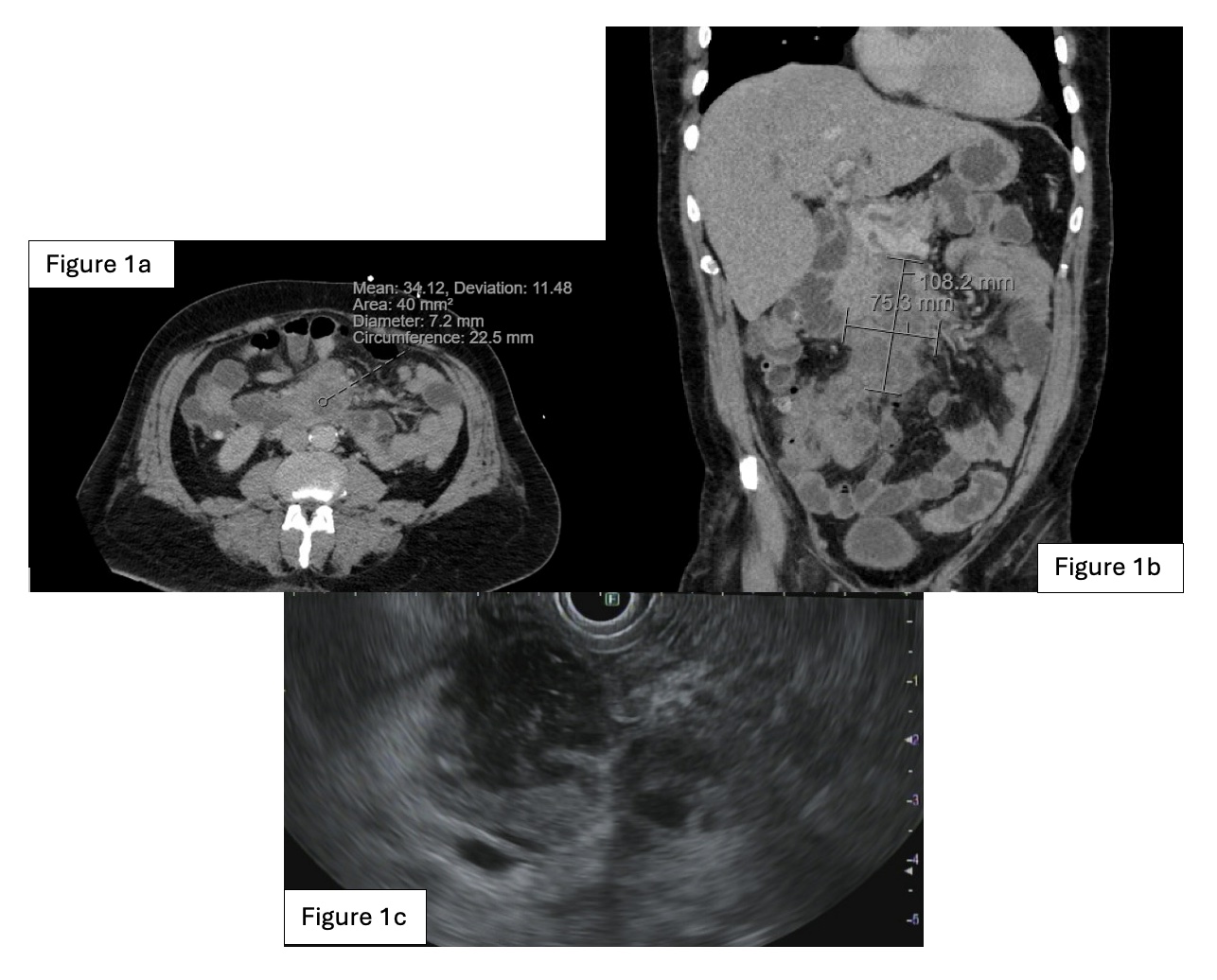Tuesday Poster Session
Category: Interventional Endoscopy
P4536 - Septic Shock Due to Fusiform Bacterium Nucleatum After Endoscopic Fine Needle Biopsy of a Large Abdominal Mass
Tuesday, October 29, 2024
10:30 AM - 4:00 PM ET
Location: Exhibit Hall E

Has Audio

Sydney Donohue, MD
University Hospitals Cleveland Medical Center, Case Western Reserve University
Cleveland, OH
Presenting Author(s)
Sydney Donohue, MD1, Sameer K. Avasarala, MD1, Ashley Faulx, MD2
1University Hospitals Cleveland Medical Center, Case Western Reserve University, Cleveland, OH; 2Digestive Health Institute, University Hospitals Cleveland Medical Center, Cleveland, OH
Introduction: Endoscopic ultrasound-guided fine needle biopsy (EUS-FNB) is often used to diagnose lesions within the proximity of the gastrointestinal tract. Septic shock after EUS-FNB has rarely been reported in the literature. We present a unique case of septic shock secondary to FNB of a suspected cancerous mesenteric lymph node in a patient with a history of non-Hodgkin lymphoma (NHL).
Case Description/Methods: A 63-year-old man with a past medical history of NHL presented to the endoscopy suite for an outpatient EUS-FNB of an enlarged mesenteric lymph node. Workup for recurrence was started due to a 30-pound weight loss in three months, epigastric pain, and night sweats. A PET-CT revealed FDG avid lesions in the ascending and sigmoid colon with enlarged ileocolic and mesenteric lymph nodes. A colonoscopy had been performed and demonstrated diverticulosis. An abdominal CT, before FNB, identified significant enlargement of an ill-defined, infiltrative soft tissue mass in the mesentery. EUS then demonstrated an irregular, heterogeneous mesenteric mass with poorly defined margins. Three passes were taken with a 22 gauge needle using a transduodenal approach. The sample was purulent. Post-procedure, the patient was admitted to the hospital given concern for infection. He acutely decompensated and was transferred to the medical intensive care unit. He received fluid resuscitation, vasopressors, and broad-spectrum antibiotics. Blood cultures were positive for fusobacterium nucleatum. Repeat CT imaging after a course of antibiotics showed an interval decrease in the size of the abdominopelvic soft tissue lesions. Due to improvement with antibiotics, the clinical picture was most consistent with diverticulitis, not a recurrence of his NHL, leading to abdominal abscesses that were then aspirated, seeding the bacteria into the bloodstream and causing septic shock.
Discussion: EUS-FNB is a very safe method for tissue acquisition with a very low overall complication rate of approximately 0-2.5% and bacteremia at approximately 2.0%. The ASGE does not recommend prophylactic antibiotics for EUS-FNB of soft tissue lesions. This case illustrates that physicians should consider prophylactic antibiotic administration in patients if an alternative diagnosis, such as an abscess, is suspected, to help mitigate against bacteremia.

Disclosures:
Sydney Donohue, MD1, Sameer K. Avasarala, MD1, Ashley Faulx, MD2. P4536 - Septic Shock Due to Fusiform Bacterium Nucleatum After Endoscopic Fine Needle Biopsy of a Large Abdominal Mass, ACG 2024 Annual Scientific Meeting Abstracts. Philadelphia, PA: American College of Gastroenterology.
1University Hospitals Cleveland Medical Center, Case Western Reserve University, Cleveland, OH; 2Digestive Health Institute, University Hospitals Cleveland Medical Center, Cleveland, OH
Introduction: Endoscopic ultrasound-guided fine needle biopsy (EUS-FNB) is often used to diagnose lesions within the proximity of the gastrointestinal tract. Septic shock after EUS-FNB has rarely been reported in the literature. We present a unique case of septic shock secondary to FNB of a suspected cancerous mesenteric lymph node in a patient with a history of non-Hodgkin lymphoma (NHL).
Case Description/Methods: A 63-year-old man with a past medical history of NHL presented to the endoscopy suite for an outpatient EUS-FNB of an enlarged mesenteric lymph node. Workup for recurrence was started due to a 30-pound weight loss in three months, epigastric pain, and night sweats. A PET-CT revealed FDG avid lesions in the ascending and sigmoid colon with enlarged ileocolic and mesenteric lymph nodes. A colonoscopy had been performed and demonstrated diverticulosis. An abdominal CT, before FNB, identified significant enlargement of an ill-defined, infiltrative soft tissue mass in the mesentery. EUS then demonstrated an irregular, heterogeneous mesenteric mass with poorly defined margins. Three passes were taken with a 22 gauge needle using a transduodenal approach. The sample was purulent. Post-procedure, the patient was admitted to the hospital given concern for infection. He acutely decompensated and was transferred to the medical intensive care unit. He received fluid resuscitation, vasopressors, and broad-spectrum antibiotics. Blood cultures were positive for fusobacterium nucleatum. Repeat CT imaging after a course of antibiotics showed an interval decrease in the size of the abdominopelvic soft tissue lesions. Due to improvement with antibiotics, the clinical picture was most consistent with diverticulitis, not a recurrence of his NHL, leading to abdominal abscesses that were then aspirated, seeding the bacteria into the bloodstream and causing septic shock.
Discussion: EUS-FNB is a very safe method for tissue acquisition with a very low overall complication rate of approximately 0-2.5% and bacteremia at approximately 2.0%. The ASGE does not recommend prophylactic antibiotics for EUS-FNB of soft tissue lesions. This case illustrates that physicians should consider prophylactic antibiotic administration in patients if an alternative diagnosis, such as an abscess, is suspected, to help mitigate against bacteremia.

Figure: Figure 1a, 1b: ill-defined mesenteric soft tissue lesion at the root of the mesentery adjacent to the SMV measuring 10.8 x 7.5 cm with increased internal areas of hypodensity
Figure 1c: EUS revealing the mesenteric soft tissue lesion
Figure 1c: EUS revealing the mesenteric soft tissue lesion
Disclosures:
Sydney Donohue indicated no relevant financial relationships.
Sameer Avasarala indicated no relevant financial relationships.
Ashley Faulx: Steris – Consultant.
Sydney Donohue, MD1, Sameer K. Avasarala, MD1, Ashley Faulx, MD2. P4536 - Septic Shock Due to Fusiform Bacterium Nucleatum After Endoscopic Fine Needle Biopsy of a Large Abdominal Mass, ACG 2024 Annual Scientific Meeting Abstracts. Philadelphia, PA: American College of Gastroenterology.
